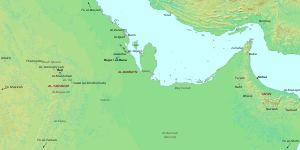
Al-Zarah (Arabic: الزارة) was an ancient and medieval settlement of Eastern Arabia. Although no longer extant, it is believed to have been situated near the modern city of al-Qatif.
Location[edit]
Al-Zarah was a port town located in the area of the al-Qatif oasis, near the coast of the Persian Gulf.[1] In the early Islamic period it was considered to be part of the region of al-Bahrayn, which then encompassed much of the eastern Arabian shoreline and adjacent territories,[2] and mentions of it were included in accounts of the area by geographers such as Ibn al-Faqih (fl. 902) and Ibn Khurradadhbih (d. 912).[3] The anonymous author of the Kitab al-manasik wa-amakin turuq al-hajj wa-ma'alim al-jazirah, writing in the ninth or tenth centuries, described it as laying between al-Uqayr and Qulay'a, and added that its inhabitants fed primarily on dates and fish.[4]
Modern scholars have proposed various possibilities for the former location of the town. The Saudi historian Hamad al-Jassir identified al-Zarah with the modern al-Awamiyyah, five kilometers west of al-Qatif, while D. T. Potts suggested that it may have been located at the more southerly Dhahran.[5] According to Farouk Omar, the site of the settlement is now marked by the modern name of al-Ramada.[6]
History[edit]
In the pre-Islamic era al-Zarah was an important commercial center along the Arabian coast.[6] By the early seventh century al-Bahrayn had come to be dominated by the Arab tribes of Abd al-Qays, Bakr ibn Wa'il, and Tamim,[7] but the town itself was also likely host to a considerable population of non-Arab residents.[8] As with the rest of region, al-Zarah was subject to Persian control during this period, and it was the seat of a Sassanid marzban or margrave.[9]
Following the death of Muhammad in 632, al-Zarah briefly emerged as a local center of anti-Muslim resistance. During the ridda wars in the caliphate of Abu Bakr, the Persian governor Azad Peroz and a number of Magians refused to pay the jizya and fortified themselves in the town, which was then subjected to a siege by al-Ala ibn al-Hadrami. The garrison held out until the Muslims managed to cut off the water supply, at which point it came to terms and agreed to hand over to al-Ala one-third of the town, one-third of its gold and silver, and half of its outlying parts in c. 634.[10]
At the end of the ninth century al-Zarah was governed by one al-Hasan ibn al-Awwam, a member of the Azd, but a short time later it was burnt down during the Qarmatian conquest of al-Bahrayn.[11] The town subsequently lapsed into obscurity, and by the turn of the thirteenth century the historian Majd al-Din ibn al-Athir considered it to no longer be a place name.[12]
Notes[edit]
- ^ Caskel 1960, pp. 72–73.
- ^ Omar 1987, pp. 156 ff., 158; Al-Hadithi 2014, pp. 251 ff.
- ^ Al-Hadithi 2014, p. 269.
- ^ Lecker 2002, p. 120. The same source adds that the town belonged to an Ahmad ibn Salm/Salim al-'Abdi, the chief of the people of al-Qatif, and that it was inhabited by the 'Abd al-Qays.
- ^ Lecker 2002, p. 121 & n. 57.
- ^ a b Omar 1987, p. 158.
- ^ Abu Ezzah 1979, pp. 53–54.
- ^ Caskel 1960, p. 73.
- ^ Lecker 2002, p. 122; Omar 1987, p. 158.
- ^ Lecker 2002, p. 121; Omar 1987, p. 158; Tafazzoli 1987, p. 173; Caskel 1960, p. 73; Al-Baladhuri 1916, pp. 129–30; Yaqut 1867, p. 907.
- ^ Al-Mas'udi 1897, p. 498; Caskel 1960, p. 73; Omar 1987, p. 158.
- ^ Lecker 2002, p. 121 n. 57.
References[edit]
- Abu Ezzah, Abdullah (1979). "The Political Situation in Eastern Arabia at the Advent of Islam". Proceedings of the Seminar for Arabian Studies. 9: 53–64. JSTOR 41223215.
- Al-Baladhuri, Ahmad ibn Jabir (1916). The Origins of the Islamic State, Part I. Trans. Philip Khuri Hitti. New York: Columbia University.
- Caskel, W. (1960). "'Abd al-Kays". In Gibb, H. A. R.; Kramers, J. H.; Lévi-Provençal, E.; Schacht, J.; Lewis, B. & Pellat, Ch. (eds.). The Encyclopaedia of Islam, Second Edition. Volume I: A–B. Leiden: E. J. Brill. pp. 72–74. OCLC 495469456.
- Al-Hadithi, Qothan Abdel Sattar (2014). "The Bahrain of the geographers". In al-Khalifa, Shaikh Abdullah bin Khalid; Rice, Michael (eds.). Bahrain through the ages, the History. London and New York: Routledge. pp. 251–278. ISBN 978-0-7103-0272-4.
- Lecker, Michael (2002). "The Levying of Taxes for the Sassanians in Pre-Islamic Medina". Jerusalem Studies in Arabic and Islam. 27: 109–126.
- Al-Mas'udi, Ali ibn al-Husain (1897). Le livre de l'avertissement et de la revision (in French). Trans B. Carra de Vaux. Paris: Imprimerie Nationale.
- Omar, Farouk (1987). "Urban Centres in the Gulf during the Early Islamic Period: A Historical Study". Bulletin (British Society for Middle Eastern Studies). 14 (2): 156–161. doi:10.1080/13530198808705462. JSTOR 194381.
- Tafazzoli, A. (1987). "ĀZĀD FĪRŪZ". Encyclopædia Iranica, Vol. III, Fasc. 2. p. 173.
- Yaqut, Ibn 'Abdallah al-Hamawi (1867). Wüstenfeld, Ferdinand (ed.). Jacut's Geographisches Wörterbuch, Zweiter Band (in Arabic). Leipzig: Brokhaus.